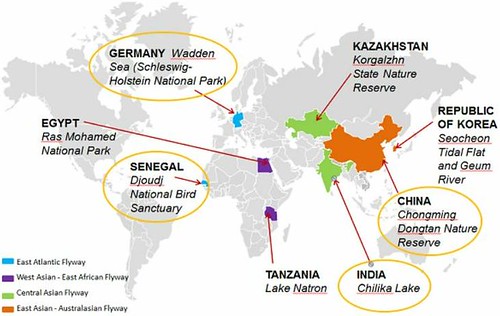遠道而來的賞鳥客,現在除了旅遊觀光,還可以兼拚保育了。
今年,世界候鳥日首次將永續觀光產業與500億的全球候鳥保育工作接軌,透過觀光旅遊業創造當地商機,讓當地居民有能力選擇拒絕其他環境不友善的收入來源,進而達到保育長程遷徙候鳥的目的。
許多候鳥的數量因為棲地破壞、非法與非永續狩獵、基礎建設開發、氣候變遷和疾病等因素而減少。在世界候鳥日當天,聯合國世界旅遊組織(UNWTO)為「目的地航道」(Destination Flyway)新計畫揭開序幕。
有10億觀光客,就有10億個保護候鳥的機會
目的地航道計畫,為永續旅遊管理和候鳥航道沿線旅遊業的多樣化提供了適當架構。此計畫由UNWTO主持,旨在創造營收,改善生物多樣性的管理,並將生態旅遊的益處推廣給當地社群,也為遊客創造更佳的旅遊經驗。
遷徙性野生動物保育協定執行秘書Bradnee Chambers說:「在全球數百萬美元野生動物觀賞產業中,賞鳥是相當重要的一環,為當地社群創造可觀的收入和工作機會,尤其是開發中國家。」
UNWTO秘書長Taleb Rifai說:「旅遊業肩負保護生物多樣性的責任。UNWTO主持的目的地航道計畫是旅遊業和生物多樣性能相輔相成的實例。我們邀請所有人一起將10億觀光客變成10億個保護候鳥的機會。」
全球精選4航線8停留點 當地社群協助觀測
世界候鳥日始於2006年,是一年一度推廣候鳥保育意識的活動。每年5月的第2個周末,全世界超過70個國家舉辦相關慶祝活動,如賞鳥旅遊、鳥類相關慶典、展覽和繪畫比賽。
世界候鳥日也領導接下來一整年的候鳥保育活動,援助1850個季節性候鳥鳥種的保育工作,通常是往來於南北向自然航線繁殖、過冬和棲息的候鳥。
英國國際鳥盟臨時執行長Hazell Shokellu博士表示,觀光與保育的結合是國際鳥盟120個夥伴團體的合作重心,「今年目的地航道計畫加強了國際鳥盟的部分工作重點,包括和當地社群結盟,以互助和促進當地生計的方式保育候鳥停留地點、物種和棲地。」
目的地航道計畫與合作團體從全球4條主要遷徙航線上選出8個停留點,在每個地點和當地社群合作,蒐集大量候鳥相關資料和辨識遷徙路徑。
其中之一是坦尚尼亞北部近肯亞邊界的納特龍湖,這裡棲息著全世界75%的小紅鸛,也是小紅鸛在東非的唯一繁殖地點。除了納特龍湖,另外7個停留點和棲地分別位於中國、埃及、德國、印度、哈薩克斯坦、南韓和塞內加爾。
Bird-loving tourists can help to conserve the birds that entice them far from home. This year, for the first time, World Migratory Bird Day is linking sustainable tourism with conservation of the 50 billion migratory birds now transiting their flyways around the world.
Many migratory bird species are in decline, threatened by habitat destruction and degradation, illegal and unsustainable hunting, infrastructure development, climate change and disease. Flyways provide a framework for international collaboration and focus attention on the needs of migratory birds.
Through the new Destination Flyways project led by the UN World Tourism Organization and introduced on World Migratory Bird Day, these long-distance traveling birds will benefit from tourism, when it supports local economies that can then afford to reject other, less environmentally-friendly sources of income.
One of the eight sites selected for the Destination Flyways project is Lake Natron in Tanzania’s remote north near the Kenyan border. Inhabited by 75 percent of the world’s population of the Lesser Flamingo, Lake Natron is the only breeding ground for this species in East Africa.
By providing an adequate framework for sustainable tourism management and diversifying the tourism offered along the flyways, Destination Flyways aims to generate revenue for improved management of biodiversity and spread the benefits of tourism to local communities, while creating attractive experiences for tourists.
Along with Lake Natron, seven other bird sites and habitats in China, Egypt, Germany, India, Kazakhstan, South Korea and Senegal have been shortlisted for inclusion in the Destination Flyways project.
“Tourism has a major responsibility in advancing biodiversity protection,” said World Tourism Organization Secretary-General Taleb Rifai. “The UNWTO-led Destination Flyways Project is a perfect example of how tourism and biodiversity can benefit from each other.”
“On this World Migratory Bird Day, we invite all to help us turn one billion tourists into one billion opportunities to protect the world’s original long-distance travellers,” said Rifai.
Held every year on the second weekend in May, the World Migratory Bird Day this year was celebrated in more than 70 countries.
The weekend leads to a year full of activities that support the survival of the 1,850 bird species that migrate from one location to another in a regular seasonal movement, often north and south along a natural flyway between breeding and wintering grounds.
Dr. Hazell Shokellu Thompson, interim chief executive with the UK-based nonprofit partnership BirdLife International, says the tourism-conservation link is central to the way her 120 partner groups interact.
“This year’s theme of Destination Flyways reinforces some of the key ways in which the BirdLife Partnership works, linking local communities to save sites, species and habitats in a coordinated way and enhancing local livelihoods,” Thompson said.
“Bird-watching is an important component of a global multi-million dollar wildlife-watching industry and provides a significant source of income and employment for a growing number of communities, especially in developing countries,” said CMS, the Convention on the Conservation of Migratory Species of Wild Animals, Executive Secretary Bradnee Chambers
World Migratory Bird Day began in 2006 as an annual awareness-raising campaign. On the second weekend each May, people around the world take action and organize public events such as birdwatching trips, bird festivals, exhibitions and painting competitions.
Eight Destination Flyway project sites along four of the world’s flyways have been preselected with partners. For each site, extensive data collection and identification of the way forward together with local partners are in progress.
※ 全文及圖片詳見:ENS









